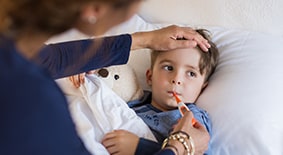Pediatrician, Urgent Care or Emergency Care? Know Where to Take Your Child.
Updated 11/16/22
If your child is sick or injured, it is important to know where to take them for care. Learn what conditions can be treated at a pediatric urgent care center.
What RSV Looks and Sounds Like in Babies
Parents and caregivers, please watch. RSV can affect babies and kids of all ages, and if you see labored breathing that looks or sounds like this, contact your child’s doctor immediately. RSV (respiratory syncytial virus) can be more than a cold, and knowing the warning signs can be lifesaving.
Watch VideoWhen your child has an injury or illness at a time when his pediatrician’s office is closed, it can be hard to know what to do.
Should you take him to an urgent care center or the emergency department, or should you wait until his doctor’s office is open?
Both ERs and urgent care centers are positioned to help care for your child in unique ways. Where you go can make a difference in what medical equipment and tools are available to fully assess your child.
First of all, remember that all kids and teens should be seen and treated in a pediatric-specific healthcare facility. Here’s how to decide where to go and when.
Your child’s pediatrician, or primary care doctor, is the best person to see for regular medical care. When you have questions about your kid’s health, or are planning for the following health needs, call his pediatrician:
Stay home and contact your child’s doctor if your child has:
- Low-grade fever
- Fatigue
- Cough
- Congestion
- Sore throat
- Diarrhea
But what about when your doctor isn’t available, like at night and on weekends?
“If your child or teen is suffering from an illness or injury that isn’t chronic or life-threatening, and your pediatrician is unavailable, a pediatric urgent care center may be the best place to go,” says Deidre Stewart, MD, an area practice director for Children’s Healthcare of Atlanta Urgent Care. “When possible, choosing a pediatric urgent care center will give you access to doctors and nurses who are specially trained to diagnose and care for kids.”
A pediatric urgent care center can handle a variety of medical issues that need prompt treatment. Some centers even allow you to save your spot online, which means you can pick a time to arrive and begin the check-in process.
Consider taking your child to a pediatric urgent care center when his regular doctor isn’t available, and he:
- Has a fever accompanied by cold symptoms that you suspect might be the flu.
- Has a minor cut that may need stitches.
- Is tugging at his ear and might have an ear infection.
- Needs an X-ray.
- Has a sore throat with or without white patches on the tonsils.
- May have a sprain or minor bone fracture, and the bone is not coming out of the skin.
- Has mild wheezing but is not having trouble breathing.
- Is having an allergic reaction but is not having trouble breathing.
- Has a mild skin rash.
- Has a possible head injury, but has not lost consciousness.
- Is vomiting or has diarrhea without blood in the stool.
- Has red, inflamed eyes with or without discharge.
- Has a headache or migraine without numbness, tingling or weakness.
- Had a seizure with fever that stops on its own.
- Has a minor burn.

Deciding between Urgent Care and the ER
Our chart can help you decide if your child’s condition can be treated at an Urgent Care Center or may require an Emergency Department visit.
Learn MoreFor more serious injuries or illnesses, you’ll need to take your child directly to the emergency department.
“Hospital emergency departments are open around-the-clock and are prepared for every kind of medical emergency,” said Mark Griffiths, MD, Emergency Medicine Physician and Medical Director of Emergency Services at Children’s at Hughes Spalding Hospital.
Head to the nearest emergency department if your child:
- Is younger than 2 months and has a fever of 100.4°F (38°C) or higher.
- Has possibly swallowed a button battery.
- Has a suspected fracture with visible swelling or unevenness and bumps in the injured area (a displaced bone requires realignment under sedation).
- Has ingested a poisonous substance or taken too much medicine.
- Has a severe burn, such as deep burns covering large parts of the body surface, or on the face, extremities or genitalia).
- Has hit his head and lost consciousness, even for a few seconds.
- Has difficulty keeping fluids down
- Has changes in alertness or unusual trouble waking
- Has bluish lips or face
- Shows signs of dehydration, including very dry lips and mouth, absence of urination for more than 12 hours, and lethargy and confusion.
- Has Trouble breathing (including heavy, fast breathing and is gasping for air)
- Has persistent chest pain or pressure
- Has gaping cuts.
- Has a skin rash that is oozing.
- Has a complex chronic illness.
- Has a psychiatric issue.
If your child’s not suffering a life-threatening injury, illness or symptom, and you’re still unsure of where to go, call your pediatrician’s office before deciding between visiting a pediatric urgent care center or emergency department. Even if it’s not during regular office hours, most pediatrician’s offices should have a doctor on call who can advise you on where to take your child.
Keeping Your Child’s Illness at Bay

What if your child needs urgent care?
When your pediatrician isn’t available, our Urgent Care Center physicians are here for you—plus, they’re specially trained to diagnose and treat children’s and teens’ common illnesses and injuries.
See MoreThis content is general information and is not specific medical advice. Always consult with a doctor or healthcare provider if you have any questions or concerns about the health of a child. In case of an urgent concern or emergency, call 911 or go to the nearest emergency department right away. Some physicians and affiliated healthcare professionals on the Children’s Healthcare of Atlanta team are independent providers and are not our employees.
Contact Us 404-785-KIDS (5437)







